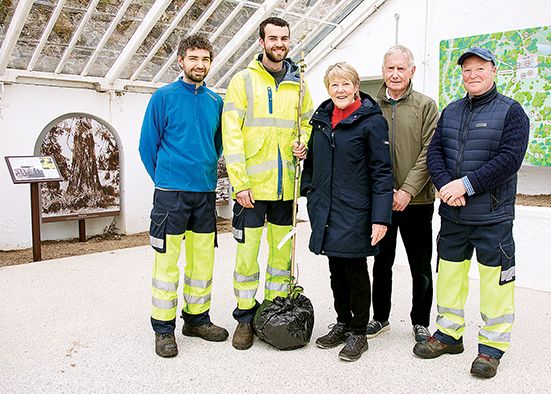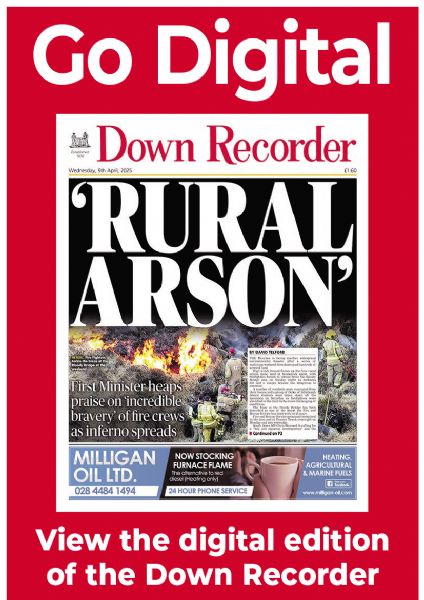December 2025 completion date for Castlewellan forest park plan
December 2025 completion date for Castlewellan forest park plan
17 May 2023

THE dedicated group set up to provide advice on the multi-million pound revitalisation of Castlewellan’s stunning forest park met recently to review the huge investment.
The second meeting of the advisory committee for the ongoing £5.5m heritage project at the park met at the Arboretum and Annesley Gardens.
Key stakeholders and professionals who have expert knowledge in the management of botanical collections and historic designed landscapes were hosted by Newry, Mourne and Down Council which, along with the National Lottery’s Heritage Lottery Fund, is financing the revitalisation project.
The advisory committee meets biannually to advise on elements of the forest park scheme and and review the restoration and development of Arboretum and Annesley Gardens.
Work is already well underway on the investment project which aims to connect people with the park’s built and natural heritage, in addition to restoring and celebrating its unique biodiversity.
It’s hoped the work will be completed by December 2025, with the local authority agreeing a lease for the core areas within the park from the Forest Service until 2045.
Proposed work includes new landscape and drainage within The Grange courtyard, a new pedestrian path from the entrance gates to the main car park, a new vehicular road off Castle Avenue to the existing car park.
There will also be a new traffic control barrier at Castle Avenue.
Caravan spaces will be relocated with the feature entrance gates at the Castle Avenue entrance restored, alongside the restoration of The Grange courtyard buildings and the reconstruction of a derelict building block.
The park’s 19th century greenhouse is also being restored with the reconstruction of the propagation house and cold frames, while one of several outbuildings will be converted to an office and volunteer space.
Elsewhere, visitor facilities will be created in the Stove Conservatory including an interpretation centre, with a platform lift installed to provide access to the terrance for people with reduced mobility.
Since 2015, the local authority has been progressing with plans to restore the natural and built heritage of the forest park with several key stakeholders including Forest Service.
The council’s vision is to create a heritage-led destination which protects the heritage of Castlewellan Forest Park for future generations, whilst also providing opportunities for local people and visitors to learn more about the landscape.
The ‘Re-rooting our past in the Future: Castlewellan Historic Demesne’ project is designed to connect people with the built and natural heritage within the forest park, as well as restoring and celebrating its unique biodiversity.
This includes the restoration of a living arboretum, containing some of the most significant collection of trees and shrubs on the island of Ireland.
As part of the project, the Grange will be developed into a visitor core with the creation of a welcome centre, community space and café facilities, with the courtyards transformed into a vibrant visitor hub and dedicated centre for community use with interpretation, activities, events, environmental education and skills development.
In addition, the landscape will be conserved and managed sensitively, protecting its plant collection and important biodiversity.
Those heavily involved in the project say that it has been designed to deliver the local authority’s vision of transforming the picturesque forest park into a “dynamic, heritage-led destination, restoring, celebrating and interpreting the natural and built heritage of the historic demesne”.
During the recent meeting, advisory committee members reviewed plans to ensure the long-term survival of the botanical/dendrological heritage of the forest park landscape.
It made several recommendations including the development of a policy for plant collections management, improving resilience of mature trees, historic planting styles, management of structural views and treatment of the shelterbelt that is a wind barrier and provides protection from soil erosion.
Drainage and disease control were also discussed with a focus on climate change and the potential impact on the collection.
Council chairman Michael Savage said the council was delighted to host the advisory committee meeting in Castlewellan.
“Attendees give their time freely to provide advice and guidance to our staff regarding the management and maintenance of the tree and plant collection,” he explained.
“To receive advice from a wide range of stakeholders on topics such as plant health, biosecurity best practice and climate change is invaluable.”
The National Lottery Heritage Fund’s senior investment manager, Angela Lavin, said it was great to see the important heritage project at Castlewellan Demesne make a positive start to plans for the natural environment within the forest park.
“Thanks to National Lottery players, we are committed to supporting projects that help habitats and species thrive, reduce and mitigate impacts of climate change and increase people’s connection with nature,” she added.
To mark the occasion of the meeting, The Irish Garden Plant Society representative Maeve Bell, presented the forest park’s head gardener, Alwyn Sinnamon, with a tree, Zelkova carpinifolia ‘Glasnevin’.
The tree was grafted from one of the most notable trees in Ireland and only 12 young trees exist.
The local council wishes to thank the volunteers of the Irish Garden Plant Society for the gift, which will add to the rare tree and plant collection in Castlewellan.
The advisory group members include the Forest Service, Irish Tree Society, The Parks Agency, International Dendrology Society, Northern Ireland Heritage Garden Trust, Royal Botanic Gardens Edinburgh, Irish Garden Plant Society, CAFRE, Department of Agriculture, Food and Marine Ireland and Kilmacurragh’s National Botanic Gardens.


